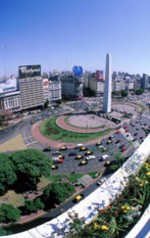Is a national historic monument and the icon of Buenos Aires. Located in the Plaza de la República, in the intersection of avenues Corrientes and 9 de Julio, it was built to commemorate the fourth centenary of the first foundation of the city
| 9 de Julio Avenue & the Obelisk. Buenos Aires, Argentina. |
| Avenida 9 de Julio is an avenue in Buenos Aires, Argentina. At 140 meters, it is the world's widest avenue. Its name honors Argentina's birthdate. (July 9, 1816). | |
The avenue's unusual width is due to the fact that it spans en entire cuadra, the distance between two streets in the checkerboard pattern used in Buenos Aires.
The distance between adjacent streets is roughly 110 meters, greater than the equivalent Manhattan distance. The street flanking 9 de Julio to the east is called Carlos Pellegrini (north of Rivadavia) and Bernardo de Irigoyen (south of Rivadavia). The street flanking 9 de Julio to the west is called Cerrito (north of Rivadavia) and Lima (south of Rivadavia). Those lateral streets (which actually just add lanes to the avenue) are included in the 140 meter calculation.


No hay comentarios:
Publicar un comentario